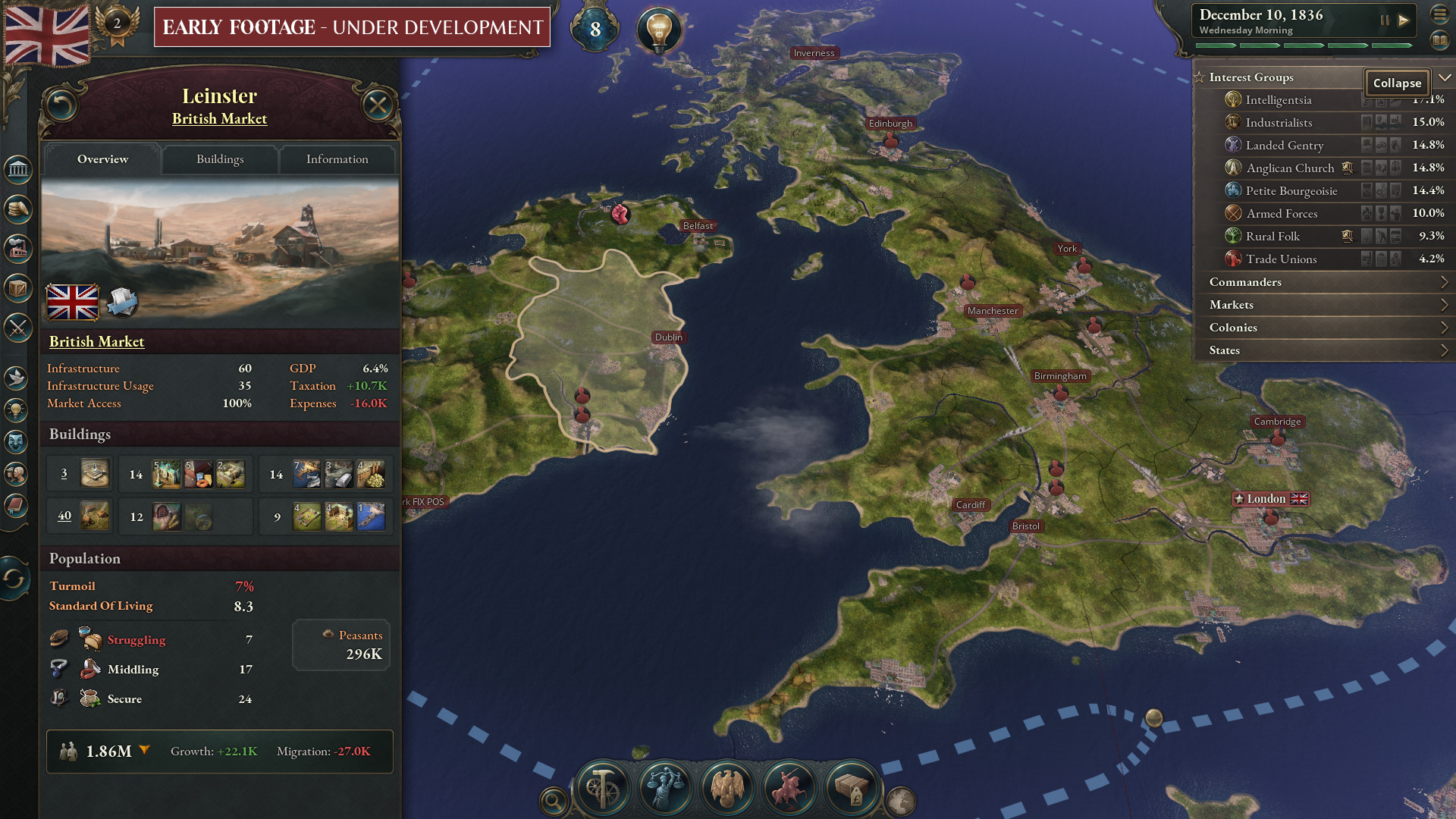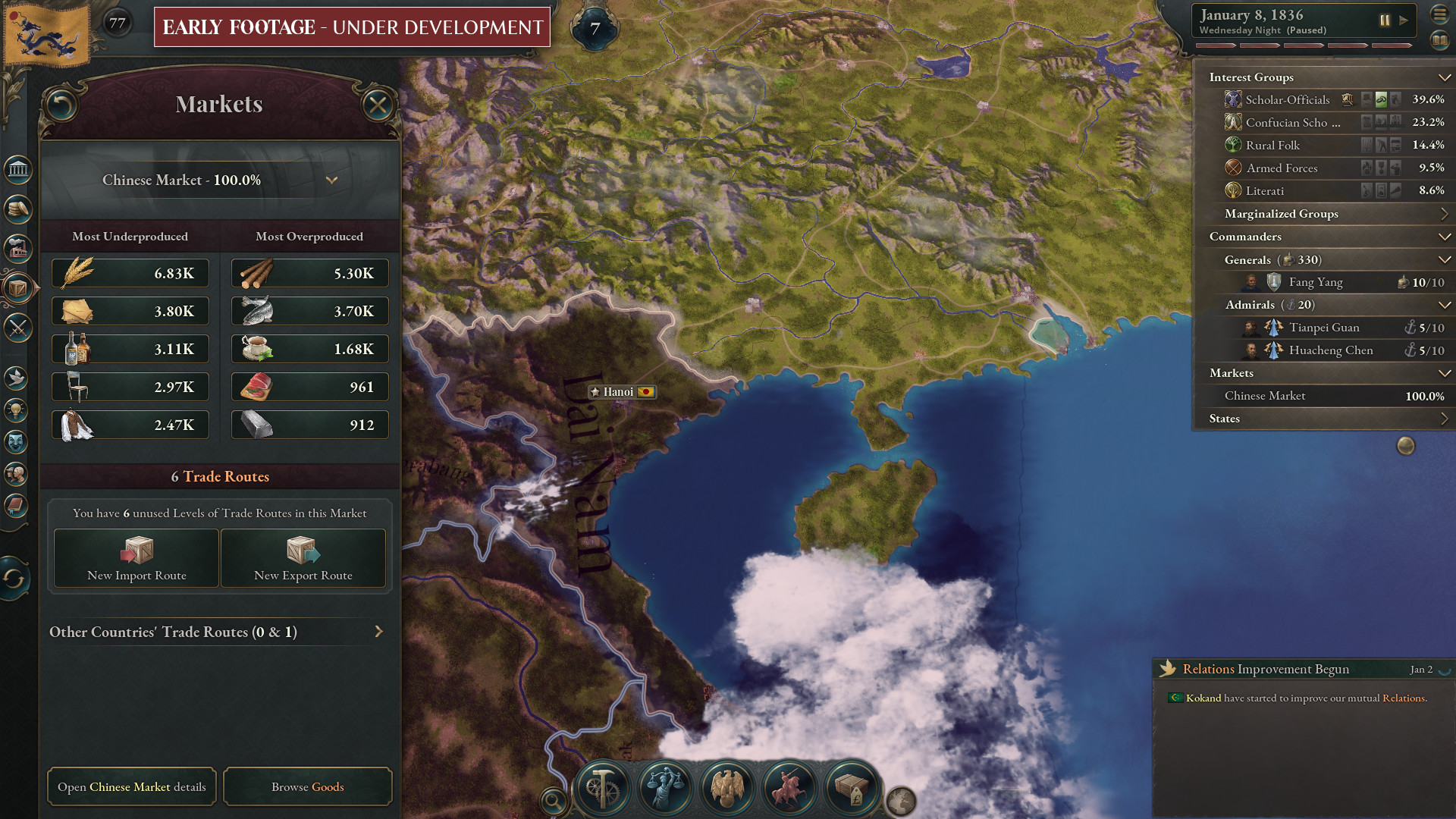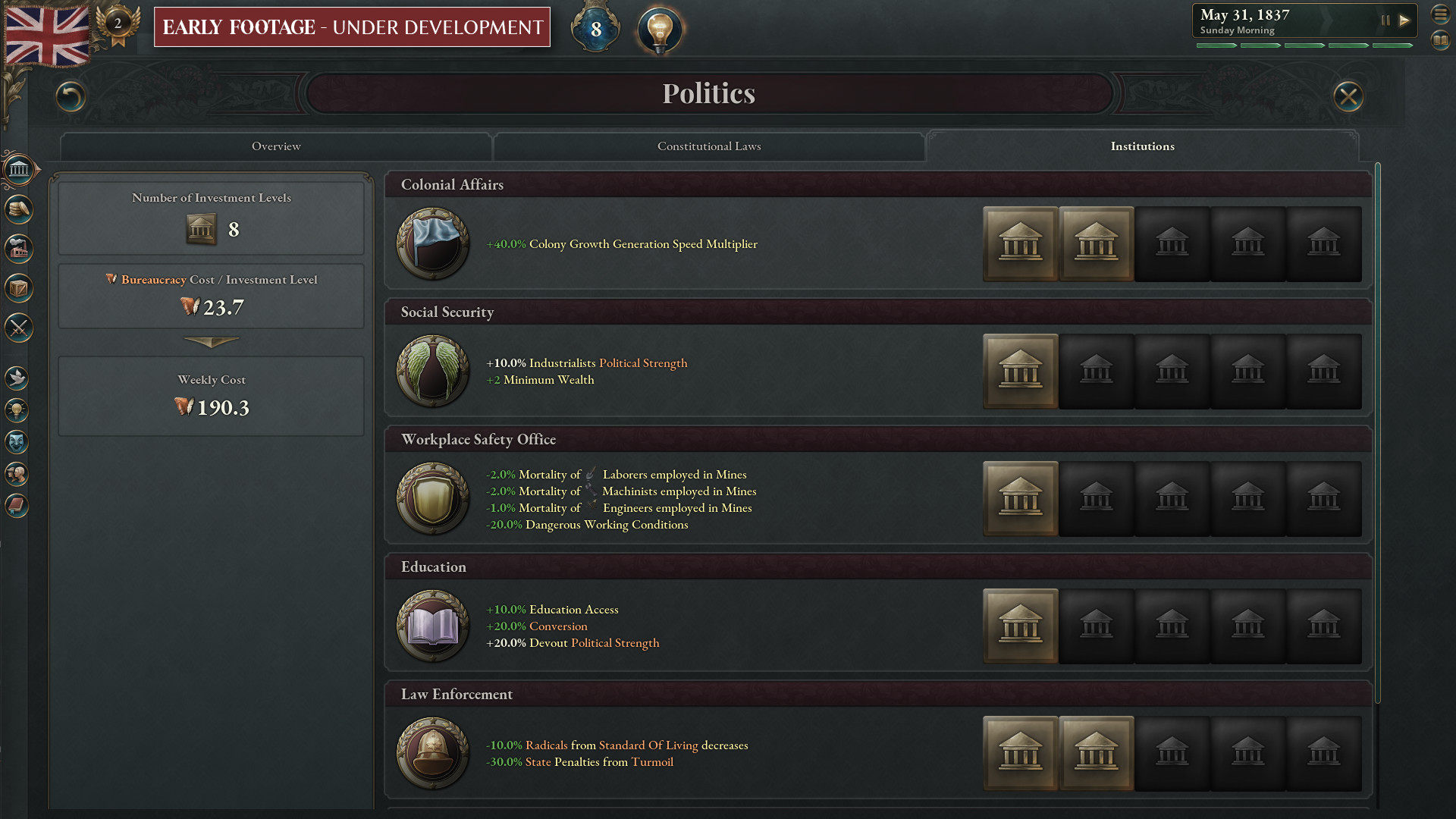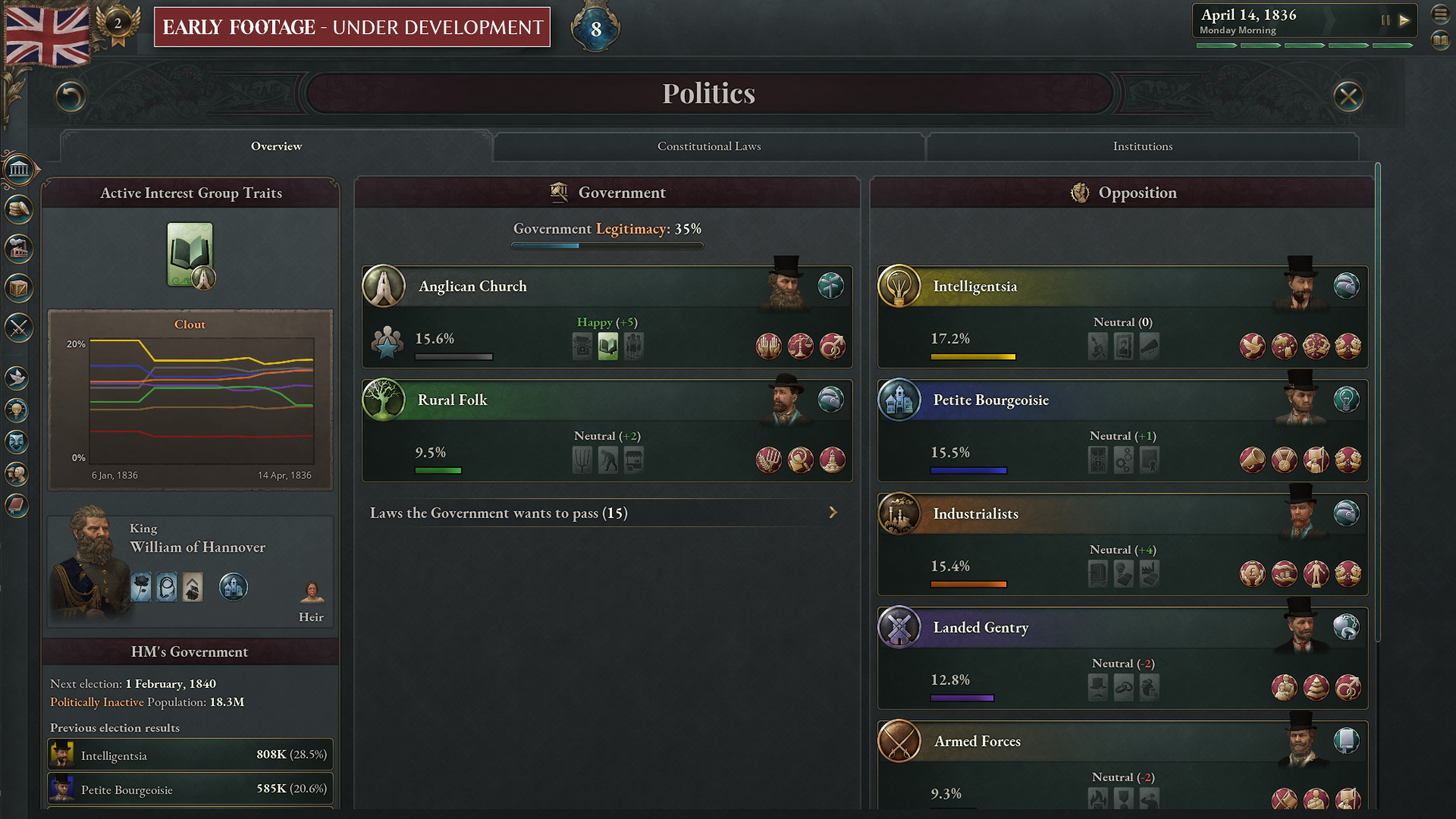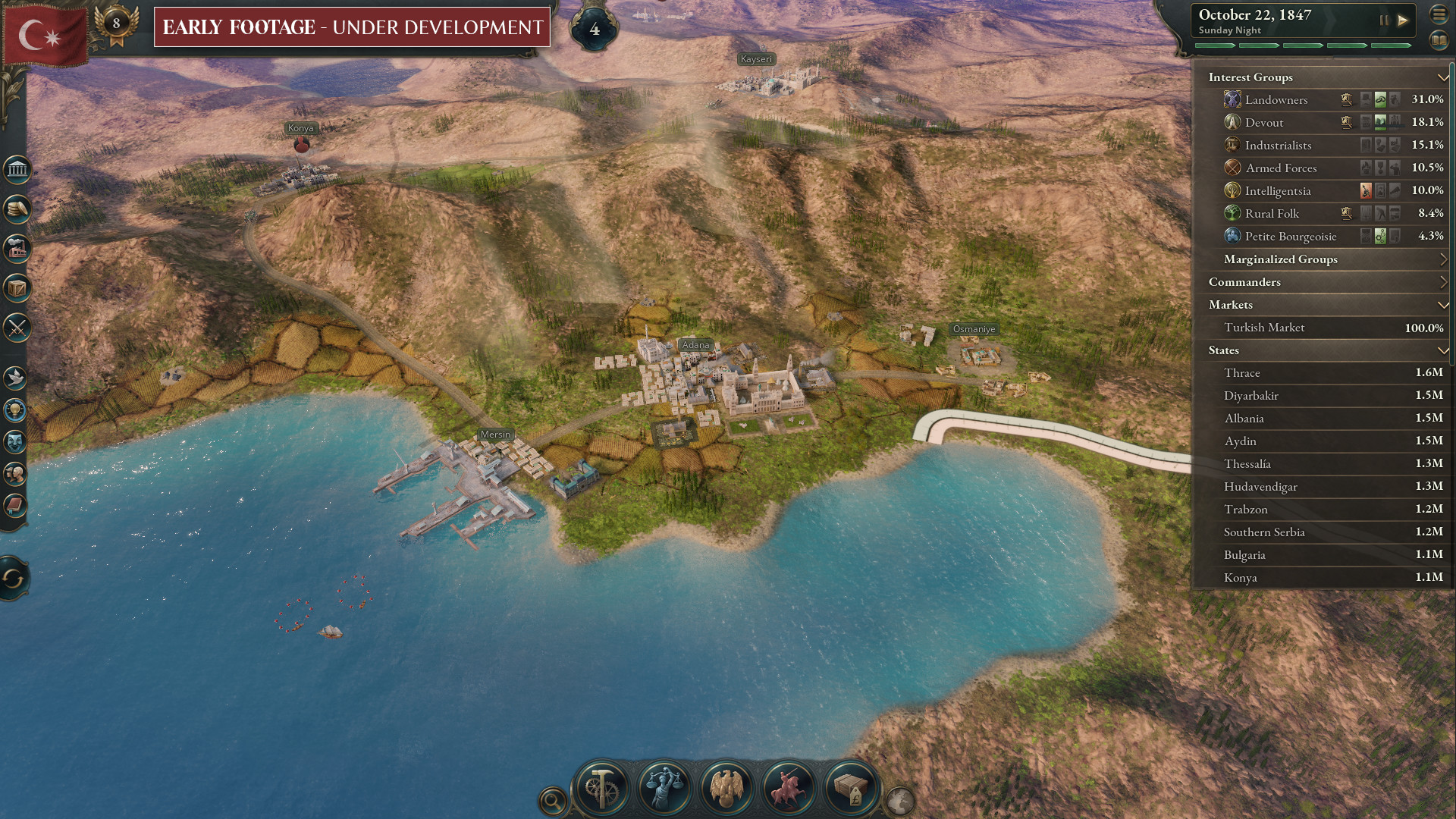SHAPE A GRAND TOMORROW
Paradox Development Studio invites you to build your ideal society in the tumult of the exciting and transformative 19th century. Balance the competing interests in your society and earn your place in the sun in Victoria 3, one of the most anticipated games in Paradox’s history.THE ULTIMATE SOCIETY SIMULATOR
- Lead dozens of world nations from 1836-1936. Agrarian or Industrial, Traditional or Radical, Peaceful or Expansionist... the choice is yours.
- Detailed population groups with their own economic needs and political desires.
- Reform your government and constitution to take advantage of new social innovations, or preserve the stability of your nation by holding fast to tradition in the face of revolutionaries.
- Research transformative new technology or ideas to improve your national situation.
DEEP ECONOMIC SYSTEM
- Expand your industry to take advantage of lucrative goods, taxing the profits to improve national prosperity.
- Import cheap raw materials to cover your basic needs while finding new markets for your finished goods.
- Secure vital goods to fuel your advanced economy and control the fate of empires.
- Balance employing available labor force with the needs for new types of workers.
PLAY ON A GRAND STAGE
- Use your diplomatic wiles to weave a tangled global web of pacts, relations, alliances, and rivalries to secure your diplomatic position on the world stage.
- Employ threats, military prowess and bluffs to persuade enemies to back down in conflicts.
- Increase your economic and military strength at the expense of rivals.
- Accumulate prestige and the respect of your rivals as you build an industrial giant at home or an empire abroad.

Happy Friday, and welcome to our third and final Dev Diary for the Anniversary week! Before we get into the meat of the diary, we have an infographic showing the progress of free updates since release, visually shown in the look back at free updates video at the start of this week:
That entre is followed up with a delightful smattering of statistics from the game, can you see the difference in how many yellow Prussias there have been since last time?
That is all from me, Community Manager Pelly, I hope you enjoy the Dev Diary proper from Hansi and Victoria!
[hr][/hr]
India Map Rework
Welcome, map affectionados, to this weeks map bonanza. I am Lufhansi, narrative designer and main map man on Victoria 3, and I will be your host for this evening.
As you might expect, Pivot of Empires narrative content for India will be accompanied by relevant map work, including new and reworked state regions, cultures, and countries for the Indian subcontinent. In addition to miscellaneous other, exciting additions that will be detailed further down. As always we got some ground to cover, so without wasting more of your time, lets get into it:


South Asia
If you find yourself thinking that India has too many tags already, this update may not be the one for you. To help illustrate the immense complexity of 19th century India, for Pivot of Empire we have added over 30 new tags to the 1836 startdate, as well as multiple new formables and releasables that these new nations can aspire towards, all with distinct identities and new flags. Former abstractions, like Orissa and Bundelkhand have been replaced by new princely states, and in Gujarat, Baroda is now simply the most important Gujarati state instead of the only one. The fan favourites of Garwhal and Manipur have made their debut, along with a slew of other states and nations, ranging from the the decentralised tribes along the Assam-Burma border in the north-east, to the British crown colony of Ceylon and the Sultanate of the Maldives in the south-west.
In the northwest, the Sikh Empire, now known as the Khalsa Raj, faces a somewhat different position compared to previous patches. In addition to grappling with the internal intrigues of the Lahore courthistorically a source of weakness for the empire during its critical struggle against the Britishit must also contend with a new, powerful vassal: the ambitious Gulab Singh of Jammu, who in 1836 finds himself preoccupied with suppressing a revolt in the newly conquered region of Ladakh.


Other exciting additions include the rump state of Satara, led by the last Chhatrapati of the Maratha Empire, and the once-mighty Mughal Empire, now reduced to the confines of the city of Delhi. Although the Mughals controlling more than their own palace grounds isn't entirely historically accurate, their newfound autonomy allows them to serve as a vehicle for narrative content.

Indias state regions have also been reworked and redrawn where deemed appropriate. We have tried to strike a balance between administrative borders fitting for the 19th century, and cultural borders better reflecting the ethno-linguistic makeup of the subcontinent, all the while trying to not divide the map into too many unwieldy state regions for gameplay-purposes. Notable changes include a new East/West split for Bengal, mirroring a similar division in Punjab, along with the addition of new state regions such as the Ceded Districts and Arakan, and a reshaping/redefinition of most pre-existing state regions.

We have also added a selection of new cultures to India to showcase the extraordinary diversity of the subcontinent, such as Hindustani, Chhattisgarhi, Naga, Deccani, Pathan, Lushai, and many more.

In a similar vein, Indias hub and spline system has been reworked from the ground up, which has seen the elimination of a lot of anachronisms and misplaced hubs. So to the valiant forum member that has championed the good cause of Jamshedpur for years now, you can now rest easy, knowing that we have finally fixed its location.
And should that not be enough, well good news, because with 1.8, Victoria 3 will now have:
Dynamic Renaming


Thats right, its finally here. And what a version of it you will get! Most current dynamic naming in-game is decided by the owners cultures, the above examples being Turkish and Greek, but there are exceptions to this. For example, moving your capital to Edo as Japan will now rename the city to Tokyo, and the city of Bismarck, North Dakota, will be named Edwinton until the Iron Chancellor has actually made a name for himself, just to name a few.

And should none of the picks we have made be to your liking, then fear not! For hub and state names are now fully customizable in-game. Of course, we fully expect you all to be sensible and measured in your application of this newfound power.

For modders, it goes without saying that this is an incredibly flexible system, and we hope you will have a lot of fun with it going forward.
[hr][/hr]
Narrative Content
Hello. This is Victoria, Narrative Design Lead of Victoria 3, and today I will be covering the free narrative content and political setup changes which are coming in Update 1.8. The paid content that will be coming in Pivot of Empire will be covered in a later dev diary.
Indian Political Setup

Upon beginning the game as the East India Company, one may notice that the interest groups one must contend with are not those that they have become accustomed to. The EIC has been given a full suite of custom interest groups, designed to accurately represent the unique situation that finds itself in.
The most notable of these new interest groups is the East India Company interest group, representing European colonial interests within India. It has received a set of all-new ideologies and traits for this purpose, transforming it into a representation of the ideology, mindset, and interests of the British colonial administration. Upon the establishment of the British Raj, it will be renamed to the Government of India, but its ideology will stay essentially the same.

The new Colonialist ideology has been implemented in various places both new and old, with the East India Company as only one example. It is also used to make the Industrialists in colonial administrations support resource extraction rather than independent economic development. Their instrument in doing so is the new Extraction Economy law, which increases the efficacy of agriculture and resource industries whilst crippling the investment pool.
Most notably, Extraction Economy harms the native landowning classes ability to reinvest, representing the historical effects of the British Indian land ownership structure. The Zamindari system of land ownership was predicated upon the use of Indian landowners as tax collection agents for the British administration, under the expectation that the landowners could use their revenue for internal improvements. In reality, very few internal improvements were actually made, and Indian agriculture remained largely stagnant. Landowners estates were constantly partitioned, with chunks being sold at auction in order to make up for shortfalls in tax collection.

Whilst the Zamindari system was not the only system of land ownership put in place by the British administration, it was the dominant form in the Bengal presidency, and thus the most economically impactful. The other major land ownership system, the Ryotwari system, in which taxes were collected directly from individual peasants, is represented by persistent modifiers on southern Indian states which permit for greater self-ownership of agricultural buildings in these states.
Pictured: This land ownership setup allows for peasants in southern India to receive dividends from their plots, marginally increasing their base quality of life.

In order to represent the power structure of colonial India, British India will have one of two modifiers, depending upon whether the Company or Crown is in command. These modifiers greatly increase the political strength of bureaucrats and depress the influence of the Indian aristocracy, as well as making it nigh-impossible to create a legitimate government without the designated ruling IG in command. British India also has a custom rule for selecting its government - the leader of the Industrialists will necessarily become the next ruler of the country upon the death or removal of the previous one.

With the Industrialists transformed into a colonial bureaucratic nightmare, who will advocate for economically modernising India? Whilst the East India Company represents European colonial interests, the economic interests of the native Indian bourgeoisie are represented by the Bhadralok interest group. Bhadralok is a Bengali term which translates to gentlemen, and represents the moneyed upper classes which initially rose to prominence through collaboration with the EIC during their conquest of India. Whilst the majority of European capitalists gravitate towards the EIC, Indian capitalists will join the Bhadraloks instead.
Once it achieves independence, of course, Indias Industrialists will return to their normal role as the Indian industrial upper classes, and the Bhadraloks will once more represent exclusively the petit-bourgeoisie.
The Bhadraloks start with two ideologies that differ from the standard petit-bourgeoisie, Sovereignist and Modernizer. Fans of Colossus of the South may note that Modernizer is used for the Brazilian PB past a certain point - its use has been expanded to the PB across the Indian subcontinent.

The Sovereignist ideology replaces Patriotic, making the Indian PB support a lessening of discrimination and restrictions upon political expression. If India is to achieve independence, however, this ideology will immediately switch back to the default Patriotic. The Bhadraloks will not support a discriminatory British police state, but this does not mean that they oppose a discriminatory Indian police state. This ideology switching is used throughout India content, such as with the new Minoritarian Traditionalist ideology.
Pictured: I am pleased to introduce something we have been missing since release - hypocrisy mechanics.

The Minoritarian Traditionalist ideology prevents leaders from supporting State Religion if the countrys state religion does not match their personal religion. If the countrys religion ever switches to their personal religion, however, they will stop supporting secularism and immediately begin supporting State Religion again. These ideology switches are handled in on_actions, as well as various cases throughout the narrative content.
There are many other changes to pop attraction values and traits, but to go over the changes to every interest group in depth would, unfortunately, put me over the per-post image limit.
Finally, here is the new East India Company law setup.

Whilst the EIC possesses the Oligarchy and Caste Not Enforced laws, the institution of the British Raj following the Indian Uprising will lead to the enactment of Autocracy and Caste System Codified. This represents the centralisation of power in the Raj, and the efforts made by the colonial administrators of the 1860s to codify the Indian caste system into the modern, nationwide varna system.
The Indian Uprising

In the year 1857, years of mismanagement by the British East India Company spiralled into an uprising which briefly rendered a third of the Indian subcontinent ungovernable. This uprising has been referred to as the Sepoy Mutiny by various British sources, and various names from the First War of Independence to the Great Rebellion by Indian writers. For the remainder of this diary, I will refer to it as the Indian Uprising.
The Indian Uprising was previously represented by the Avert Mutiny journal entry, which would spawn the Mughal Empire as a revolt if the EIC failed to complete various journal entries. In 1.8, this journal entry has been completely reworked.

The new Unstable Raj journal entry is available upon game start for the East India Company. All Princely States will have a more concise version of this journal entry, for the purpose of tracking the level of unrest in the EIC.
The stability of each Presidency within the East India Company is tracked with its own progress bar, which increases or decreases depending on various conditions. These conditions include taxation, the liberty desire of princely states within a given region, the presence of Utilitarian administrators [more on this in a future diary], state turmoil, and more.

What is a Presidency? Historically, they were the highest-level administrative units of colonial India. In-game, their borders are determined by the various Indian strategic regions. The Presidency concept details precisely which regions equate to which Presidency.


A major event chain which will affect the stability of the Presidencies deals with the cartridges issued to Indian sepoys. After researching Rifling, a rumour will begin to spread throughout the ranks of the Companys soldiers about the nature of the cartridge grease. If mismanaged, this event chain can lead to a sharp decrease in the stability of the Presidencies.

If the stability of any Presidency drops too low for a period of 100 months, or if 25 years elapse without completing the Consolidate Colonial Rule journal entry and raising the Standard of Living of India to the requisite level, India will explode into rebellion.
Pictured: The Consolidate Colonial Rule journal entry has also been amended, removing the time limit and making some other quality of life changes.

The precise character of this rebellion depends upon which regions are most afflicted with unrest, as well as the Liberty Desire of various Princely States. If unrest is concentrated in the Bengal Presidency, the main drama of the rebellion will revolve around Delhi, and the bid of the mutinying sepoys to restore the Mughal Empire. Each Presidency possesses a major revolter - the Mughals in Bengal, Satara and the Chhatrapati of the Maratha Confederacy in Bombay, and the rebellious princely state of Kurnool in Madras.
With all of these factors, the Indian Uprising can possess endless permutations, from something similar to the bounds of the historical uprising

to a distributed revolt across multiple regions, encompassing various Princely States

to an apocalyptic collapse of British authority across the subcontinent.

If a Princely State possesses high liberty desire when the Uprising breaks out, it will have an opportunity to either join the Marathas or the Mughals, or try to forge its own path. Pledging fealty to either the Mughals or Marathas will make a princely state a vassal of the Emperor or Chhatrapati.

Once the shape of the uprising has been determined, a war will break out between a coalition of revolters and the British. In order to preserve itself, the East India Company must put down every revolter and restore their order to India.

If the British win, as they did historically, the British government will step in to reform the administration of India to ensure that this does not happen again. The East India Company will be reorganised into the British Raj, and much of its autonomy will be stripped from it.

However, what if the Indian Uprising is triumphant, and the British are driven from the subcontinent?

After losing to the revolters, the East India Company will be able to retreat to one of the three Presidencies, abandoning its holdings in all other regions. Alternatively, it may abandon India completely. Some possible outcomes from this event are below.

Once the British are gone, or reduced to a rump state hanging on to whatever they could hold against the revolt, the Indian contenders may shift to managing their newly acquired empires.
Interest Group Priority Cultures
Astute observers may note that, in the above screenshot, the leaders of the EIC and Presidency Armies are European, whilst the leaders of every other interest group are Indian. Prior to 1.8, interest groups were only able to select leaders of primary cultures. This is no longer the case. Interest groups can now be assigned priority cultures, which will force characters of an interest group to have certain cultures, given a set of conditions.
Pictured: Leaders of the Industrialists interest group in India can only be British, Scottish, or Irish for as long as British rule persists.

This has enabled us to flavour the East India Company [Industrialists] and Presidency Armies [Armed Forces] interest groups as European, whilst the other interest groups represent various classes amongst the native Indian population.
New Subject Tracks

In 1.8, two new subject types have been added, and the existing ones reconfigured into three separate tracks. Dominions now belong to a different track than puppets, and all tracks have two steps. Rather than needing to promote from a puppet to a dominion to a protectorate, puppets now directly promote to Protectorate.
Chartered Companies are a new subject type, which possess all of the autonomy of a Protectorate whilst paying a higher share of their income to their overlord. Examples of Chartered Companies include the Hudson Bay Company, East India Company, Russian-American Company, and chartered companies which may be established through African colonial administrations.
Pictured: All subject types as of 1.8.

In terms of narrative, Dominions and Colonies represent colonial governments of various types, whilst Protectorates and Puppets represent native-ruled states that nonetheless lack political autonomy. Tributaries and Vassals have remained unchanged.
Pictured: Colonies can now have subjects of their own, which means the Princely States stay safely connected to the Raj. Also visible here is a selection of new flags that weve added.

Corporate States

Pivot of Empire and Update 1.8 are largely centred around the British East India Company, a massive corporation that acts as a state. We have also added a Corporate State law. These two things are completely unrelated.
Corporate State is a new Governance Principles law added in 1.8, designed to represent states such as the Federal State of Austria, Fiume, the Italian Social Republic, and Ireland, as well as the end goals of various late-19th century and early 20th-century political movements. The Corporate State law focuses around institutionalised class collaboration as the basis of the state. In this conception of society, different classes and professions can be likened to vital organs within a single body, all serving different yet equally important functions.
Corporate State is primarily supported by Corporatists and Fascists. It also serves as a midpoint for various ideologies, being more favoured than their least favourite governance principles, but inferior to their preferred governance principles. The enactment of Corporate State serves as an endgame to a fascist playthrough, much as Council Republic serves as the endgame to a communist playthrough.
Whilst enacting Corporate State, one may choose which groups that its corporatist structure will benefit, permanently improving the clout of the players choice of interest group for as long as the law is active.

In order to represent the historical fondness that certain strains of fascism have possessed for state-supervised workers cooperatives, the Corporate State law enables the Cooperative Ownership law. Enacting Cooperative Ownership under a Corporate State will empower the petit-bourgeoisie through funnelling dividends to Shopkeepers, benefiting the states most favoured demographic.
The journal entry formerly known as the Path to Fascism has also been completely reworked in 1.8, now mirroring the Spectre Haunting the World journal entry. If the growth of the fascist movement cannot be contained, they will launch a march on your capital, possibly seizing power in the same way that Mussolini did in 1922.

The London Conference

The modern borders of Belgium and the Netherlands were only settled upon in 1839, through a process which involved every European great power. The historical result of the London Conference was the Treaty of London of 1839, a document which provided for the independence and neutrality of Belgium.
The London Conference journal entry will appear for European great powers in 1838-1839, and will permit each power to vote upon a desired settlement between the Netherlands and the newly independent Belgium. This conference can have various outcomes depending on how the Great Powers vote.
Pictured: Two of the possible outcomes.

There is more free content included in 1.8, but I have unfortunately exhausted the limit of images one can fit in a single forum post. The remainder awaits its discovery once the update is released.
And that is all. Thank you for reading. Next week, Kenneth will cover the new 2D art for Pivot of Empire.
Minimum Setup
- OS: TBC
- Processor: TBC
- Graphics: TBCSound Card: TBC
Recommended Setup
- OS: TBC
- Processor: TBC
- Graphics: TBCSound Card: TBC
[ 6487 ]
[ 1519 ]
[ 2422 ]

